 The Brexit vote has caused shockwaves throughout European economies. But there is a potentially larger economic and political problem facing the EU and the eurozone more specifically. And that is the state of the Italian banking system and the Italian economy.
The Brexit vote has caused shockwaves throughout European economies. But there is a potentially larger economic and political problem facing the EU and the eurozone more specifically. And that is the state of the Italian banking system and the Italian economy.
Italy is the third largest economy in the eurozone after Germany and France. Any serious economic weaknesses could have profound consequences for the rest of the eurozone and beyond.
At 135% of GDP, Italy’s public-sector debt is one the highest in the world; its banks are undercapitalised with a high proportion of bad debt; and it is still struggling to recover from the crisis of 2008–9. The Economist article elaborates:
The adult employment rate is lower than in any EU country bar Greece. The economy has been moribund for years, suffocated by over-regulation and feeble productivity. Amid stagnation and deflation, Italy’s banks are in deep trouble, burdened by some €360 billion of souring loans, the equivalent of a fifth of the country’s GDP. Collectively they have provisioned for only 45% of that amount. At best, Italy’s weak banks will throttle the country’s growth; at worst, some will go bust.
Since 2007, the economy has shrunk by 10%. And potential output has fallen too, as firms have closed. Unemployment is over 11%, with youth unemployment around 40%.
Things seem to be coming to a head. As confidence in the Italian banking system plummets, the Italian government would like to bail out the banks to try to restore confidence and encourage deposits and lending. But under new eurozone rules designed to protect taxpayers, it requires that the first line of support should be from bondholders. Such support is known as a ‘bail-in’.
 If bondholders were large institutional investors, this might not be such a problem, but a significant proportion of bank bonds in Italy are held by small investors, encouraged to do so by tax relief. Bailing in the banks by requiring bondholders to bear significant losses in the value of their bonds could undermine the savings of many Italians and cause them severe hardship, especially those who had saved for their retirement.
If bondholders were large institutional investors, this might not be such a problem, but a significant proportion of bank bonds in Italy are held by small investors, encouraged to do so by tax relief. Bailing in the banks by requiring bondholders to bear significant losses in the value of their bonds could undermine the savings of many Italians and cause them severe hardship, especially those who had saved for their retirement.
So what is the solution? Italian banks need recapitalising to restore confidence and prevent a more serious crisis. However, there is limited scope for bailing in, unless small investors can be protected. And eurozone rules provide little scope for government funding for the banks. These rules should be relaxed under extreme circumstances. At the same time, policy needs to focus on making Italian banking more efficient.
Meanwhile, the IMF is forecasting that Italian economic growth will be less than 1% this year and little better in 2017. Part of the problem, claims the IMF, is the Brexit vote. This has heightened financial market volatility and increasead the risks for Italy with its fragile banking system. But the problems of the Italian economy run deeper and will require various supply-side policies to tackle low productivity, corruption, public-sector inefficiency and a financial system not fit for purpose. What the mix of these policies should be – whether market based or interventionist – is not just a question of effectiveness, but of political viability and democratic support.
Articles
The Italian Job The Economist (9/7/16)
IMF warns Italy of two-decade-long recessionThe Guardian, Larry Elliott (11/7/16)
Italy economy: IMF says country has ‘two lost decades’ of growth BBC News (12/7/16)
What’s the problem with Italian banks? BBC News, Andrew Walker (10/7/16)
Why Italy’s banking crisis will shake the eurozone to its core The Telegraph, Tim Wallace Szu Ping Chan (16/8/16)
If You Thought Brexit Was Bad Wait Until The Italian Banks All Go Bust Forbes, Tim Worstall (17/7/16)
In the euro zone’s latest crisis, Italy is torn between saving the banks or saving its people Quartz, Cassie Werber (13/7/16)
Why Italy could be the next European country to face an economic crisis Vox, Timothy B. Lee (8/7/16)
Forget Brexit, Quitaly is Europe’s next worry The Guardian, Larry Elliott (26/7/16)
Report
Italy IMF Country Report No. 16/222 (July 2016)
Data
Economic Outlook OECD (June 2016) (select ‘By country’ from the left-hand panel and then choose ‘Italy’ from the pull-down menu and choose appropriate time series)
Questions
- Can changes in aggregate demand have supply-side consequences? Explain.
- Explain why there may be a downward spiral of asset sales by banks.
- How might the principle of bail-ins for undercapitalised Italian banks be pursued without being at the expense of the small saver?
- What lessons are there from Japan’s ‘three arrows’ for Italy? Does being in the eurozone constrain Italy’s ability to adopt any or all of these three categories of policy?
- Why may the Brexit vote have more serious consequences for Italy than many other European economies?
- Find out what reforms have already been adopted or are being pursued by the Italian government. How successful are they likely to be in increasing Italian growth and productivity?
- What external factors are currently (a) favourable, (b) unfavourable to improving Italian growth and productivity?
 On 15 September 2008, Lehman Brothers, the fourth-largest investment bank in the USA, filed for bankruptcy. Although the credit crisis had been building since mid 2007, the demise of Lehmans was a pivotal event in the unfolding of the financial crisis and the subsequent severe recession in most developed economies. Banks were no longer seen as safe and huge amounts of government money had to be poured into banks to shore up their capital and prevent further bankruptcies. Partial nationalisation seemed the only way of rescuing several banks and with it the global financial system.
On 15 September 2008, Lehman Brothers, the fourth-largest investment bank in the USA, filed for bankruptcy. Although the credit crisis had been building since mid 2007, the demise of Lehmans was a pivotal event in the unfolding of the financial crisis and the subsequent severe recession in most developed economies. Banks were no longer seen as safe and huge amounts of government money had to be poured into banks to shore up their capital and prevent further bankruptcies. Partial nationalisation seemed the only way of rescuing several banks and with it the global financial system.
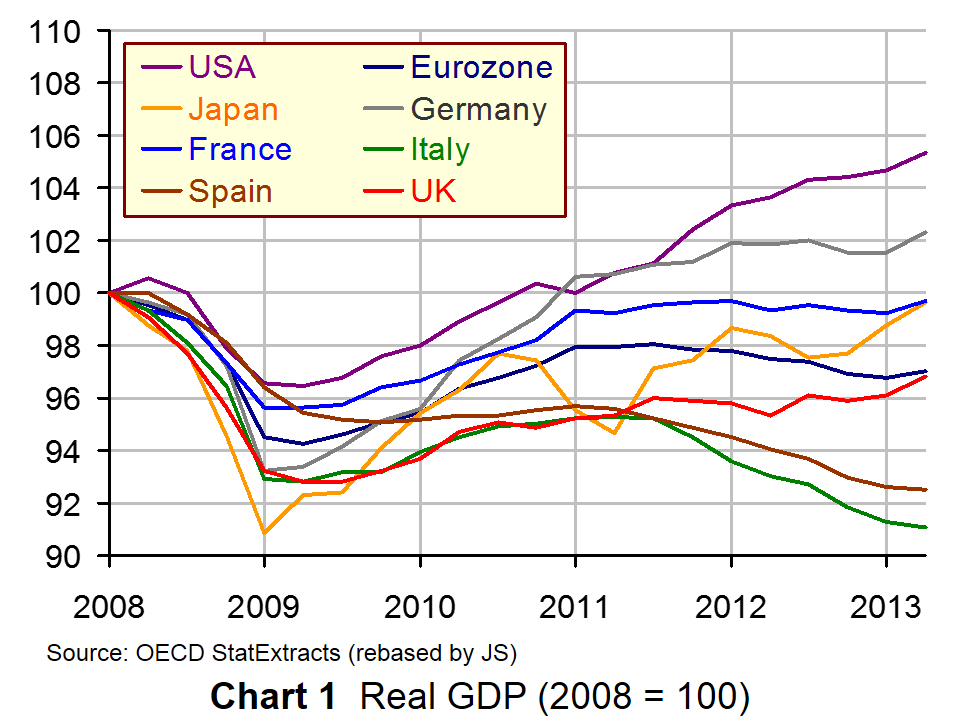 A deep and prolonged recession followed (see Chart 1: click here for a PowerPoint). In response, governments pursued expansionary fiscal policies – at least until worries about rising government deficits and debt caused a lurch to austerity policies. And central banks pursued policies of near zero interest rates and subsequently of quantitative easing. But all the time debate was taking place about how to reform banking to prevent similar crises occurring in the future.
A deep and prolonged recession followed (see Chart 1: click here for a PowerPoint). In response, governments pursued expansionary fiscal policies – at least until worries about rising government deficits and debt caused a lurch to austerity policies. And central banks pursued policies of near zero interest rates and subsequently of quantitative easing. But all the time debate was taking place about how to reform banking to prevent similar crises occurring in the future.
Solutions have included reform of the Basel banking regulations to ensure greater capital adequacy. 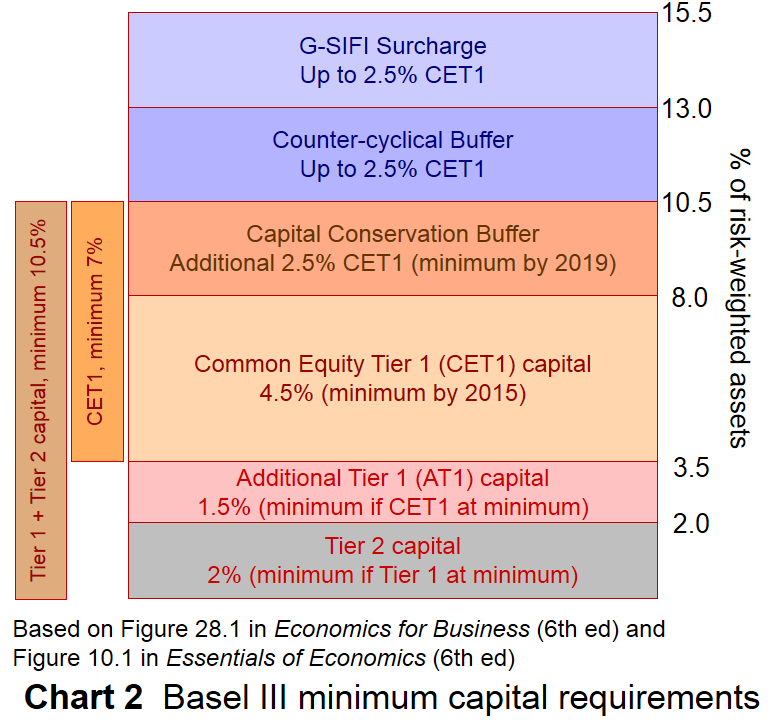 The Basel III regulations (see Chart 2) demand considerably higher capital ratios than the previous Basel II regulations.
The Basel III regulations (see Chart 2) demand considerably higher capital ratios than the previous Basel II regulations.
Other solutions have included proposals to break up banks. Indeed, just this week, the Lloyds Banking Group has hived off 631 of its branches (one sixth of the total) into a newly reformed TSB. Another proposal is to ring-fence the retail side of banks from their riskier investment divisions. In both cases the aim has been to avoid the scenario where banks are seen as too big to fail and can thus rely on governments to bail them out if they run into difficulties. Such reliance can make banks much more willing to take excessive risks. Further details of the new systems now in place are given in the Robert Peston article below.
But many critics maintain that not nearly enough has been done. Claims include:
• The Basel III rules are not tough enough and banks are still being required to hold too little capital.
• Rewards to senior bankers and traders are still excessive.
• The culture of banking, as a result, is still too risk loving in banks’ trading arms, even though they are now much more cautious about lending to firms and individuals.
• This caution has meant a continuing of the credit crunch for many small businesses.
• Higher capital adequacy ratios have reduced bank lending and have thus had a dampening effect on the real economy.
• The so-called ring-fences may not be sufficient to insulate retail banking from problems in banks’ investment divisions.
• Banks are not being required to hold sufficient liquidity to allow them to meet customers’ demands for cash in all scenarios.
• Banks’ reliance on each other still leaves a systemic risk for the banking system as a whole.
• Fading memories of the crisis are causing urgency to tackle its underlying problems to diminish.
• Problems may be brewing in less regulated parts of the banking world, such as the growing banking sector in China.
The following articles look at the lessons of the banking crisis – those that have been learned and those that have not. They look at the measures put in place and assess whether they are sufficient.
Lehman Brothers collapse, five years on: ‘We had almost no control’ The Guardian, Larry Elliott and Jill Treanor (13/9/13)
Lehman Brothers collapse: five years on, we’re still feeling the shockwaves The Guardian, Larry Elliott (13/9/13)
Five years after Lehman, could a collapse happen all over again? The Observer, Larry Elliott and Jill Treanor (15/9/13)
Five years after Lehman, all tickety-boo? BBC News, Robert Peston (9/9/13)
What have we learned from the bank crash? Independent, Yalman Onaran, Michael J Moore and Max Abelson (14/9/13)
We’ve let a good financial crisis go to waste since Lehman Brothers collapsed The Telegraph, Jeremy Warner (12/9/13)
 The Lehman legacy: Lessons learned? The Economist (9/9/13)
The Lehman legacy: Lessons learned? The Economist (9/9/13)
The dangers of debt: Lending weight The Economist (14/9/13)
The Lehman anniversary: Five years in charts The Economist (14/9/13)
Questions
- Why did Lehman Brothers collapse?
- Explain the role of the US sub-prime mortgage market in the global financial crisis of 2007/8.
- In the context of banking, what is meant by (a) capital adequacy; (b) risk-based capital adequacy ratios; (c) leverage; (d) leverage ratios?
- Explain the Basel III rules on (a) risk-based capital adequacy (see the textbook and the chart above); (b) non-risk-based leverage (introduced in 2013: see here for details).
- Explain and comment on the following statement by Adair Turner: ‘We created an over-leveraged financial system and an over-leveraged real economy. We created a system such that even if the direct cost of bank rescue was zero, the impact of their near-failure on the economy was vast.’
- Under what circumstances might the global financial system face a similar crisis to that of 2007/8 at some point in the future?
- Why is there an underlying conflict between increasing banks’ required capital adequacy and ensuring a sufficient supply of credit to consumers and business? What multiplier effects are likely to occur from an increase in the capital adequacy ratio?
 The Prudential Regulation Authority is the new UK authority in charge of banking regulation and is part of the Bank of England. In a report published on 20/6/13, the PRA found that UK banks had a capital shortfall of £27.1 billion (see Chart 1 below for details) if they were to meet the 7% common equity tier 1 (CET1) ratio: one of the capital adequacy ratios (CARs) specified under the Basel III rules (see Rebuilding UK banks: not easy to do and Chart 2 below).
The Prudential Regulation Authority is the new UK authority in charge of banking regulation and is part of the Bank of England. In a report published on 20/6/13, the PRA found that UK banks had a capital shortfall of £27.1 billion (see Chart 1 below for details) if they were to meet the 7% common equity tier 1 (CET1) ratio: one of the capital adequacy ratios (CARs) specified under the Basel III rules (see Rebuilding UK banks: not easy to do and Chart 2 below).
CET1 includes bank reserves and ordinary share capital (‘equities’). To derive the CET1 ratio, CET1 is expressed as a percentage of risk-weighted assets. As Economics for Business (6th ed) page 467 states:
Risk-weighted assets are the total value of assets, where each type of asset is multiplied by a risk factor. …Cash and government bonds have a risk factor of zero and are thus not included. Inter-bank lending between the major banks has a risk factor of 0.2 and is thus included at only 20 per cent of its value; residential mortgages have a risk factor of 0.35; personal loans, credit-card debt and overdrafts have a risk factor of 1; loans to companies carry a risk factor of 0.2, 0.5, 1 or 1.5, depending on the credit rating of the company. Thus the greater the average risk factor of a bank’s assets, the greater will be the value of its risk weighted assets, and the lower will be its CAR.
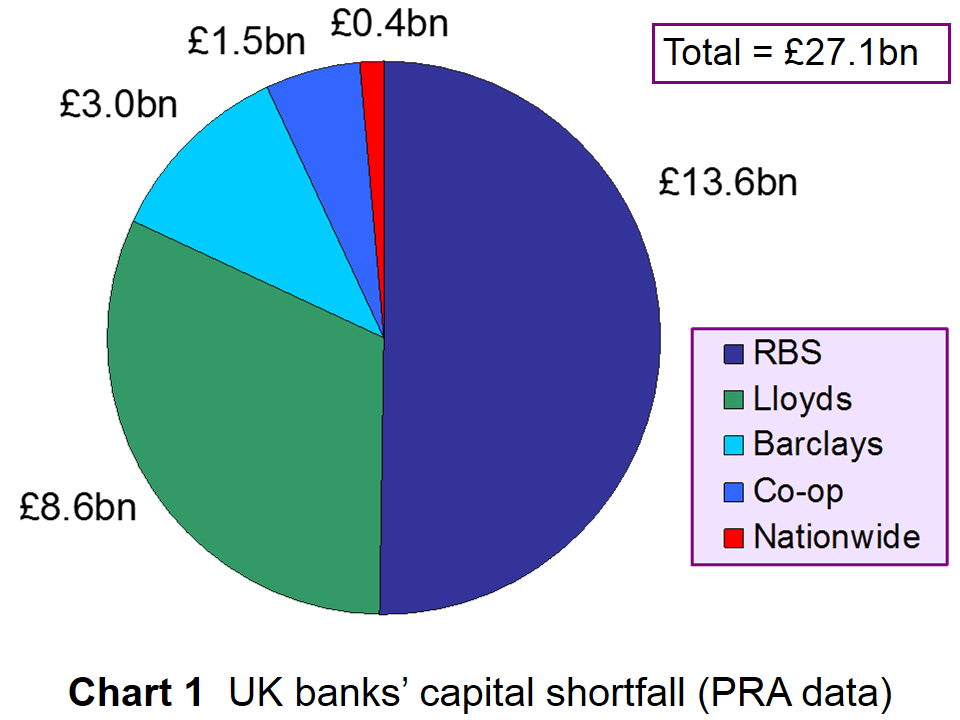 The data published by the PRA, based on end-2012 figures, show that the RBS group is responsible for around 50% of the capital shortfall, the Lloyds Banking Group around 32%, Barclays around 11%, the Co-operative around 5.5% and Nationwide the remaining 1.5%. HSBC, Santander and Standard Chartered met the 7% requirement. The PRA found that banks already were taking measures to raise £13.7bn, but this still leaves them requiring an additional £13.4 for current levels of lending.
The data published by the PRA, based on end-2012 figures, show that the RBS group is responsible for around 50% of the capital shortfall, the Lloyds Banking Group around 32%, Barclays around 11%, the Co-operative around 5.5% and Nationwide the remaining 1.5%. HSBC, Santander and Standard Chartered met the 7% requirement. The PRA found that banks already were taking measures to raise £13.7bn, but this still leaves them requiring an additional £13.4 for current levels of lending.
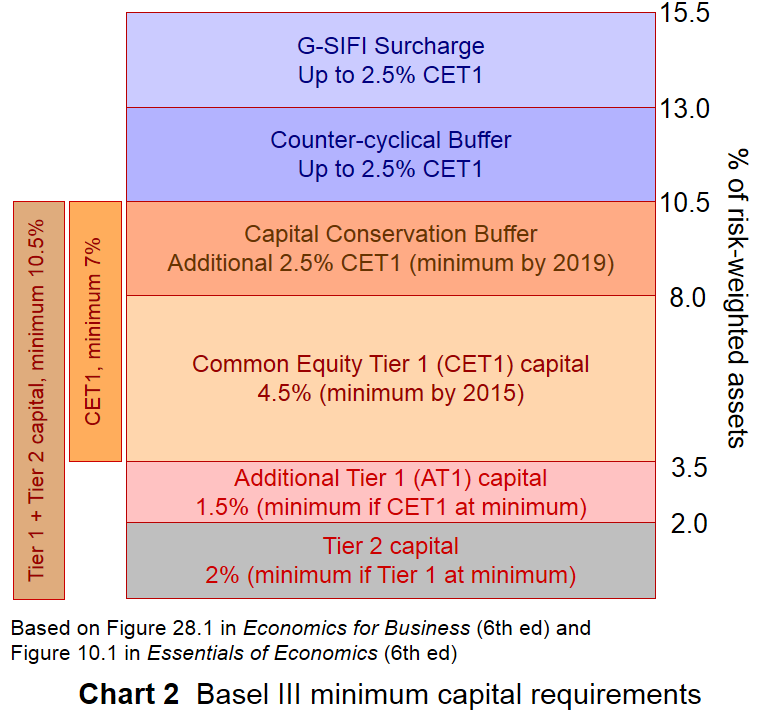 So what can the banks do? They must either raise additional capital (the numerator in the CAR) or reduce their risk-weighted assets (the denominator). Banks hope to be able to raise additional capital. For example, Lloyds is planning to sell government securities and US mortgage-backed securities and hopes to have a CET1 ratio of around 10% by the end of 2013. Generally, the banks aim to raise the required level of capital through income generation, the sale of assets and restructuring, rather than from issuing new shares.
So what can the banks do? They must either raise additional capital (the numerator in the CAR) or reduce their risk-weighted assets (the denominator). Banks hope to be able to raise additional capital. For example, Lloyds is planning to sell government securities and US mortgage-backed securities and hopes to have a CET1 ratio of around 10% by the end of 2013. Generally, the banks aim to raise the required level of capital through income generation, the sale of assets and restructuring, rather than from issuing new shares.
What both the Bank of England and the government hope is that banks do not respond by reducing lending. While that might enable them to meet the 7% ratio, it would have an undesirable dampening effect on the economy – just at a time when it is hoped that the economy is starting to recover. As Robert Peston states:
I understand that both Barclays and Nationwide feel a bit miffed about being forced to hit this tough so-called leverage ratio at this juncture, because they are rare in that they have been supporting economic recovery by increasing their net lending.
They now feel they are being penalised for doing what the government wants. So I would expect there to be something of a spat between government and regulators about all this.
Articles
Factbox – Capital shortfalls for five UK banks, mutuals Standard Chartered News (20/6/13)
UK banks ordered to plug £27.1bn capital shortfall The Guardian, Jill Treanor (20/6/13)
Barclays, Co-op, Nationwide, RBS and Lloyds responsible for higher-than-expected capital shortfall of £27.1bn The Telegraph, Harry Wilson (20/6/13)
UK banks need to plug £27bn capital hole, says PRA BBC News (20/6/13)
Barclays and Nationwide forced to strengthen BBC News, Robert Peston (20/6/13)
Five Banks Must Raise $21 Billion in Fresh Capital: BOE Bloomberg, Ben Moshinsky (20/6/13)
Will Nationwide be forced to become a bank? BBC News, Robert Peston (4/7/13)
PRA news release and data
Prudential Regulation Authority (PRA) completes capital shortfall exercise with major UK banks and building societies Bank of England: Prudential Regulation Authority (20/6/13)
Questions
- Explain what are meant by the various Basel III capital adequacy requirements
- What are the banks which were identified as having a capital shortfall doing about it?
- Would it be desirable for banks to issue additional shares? Would this make the banks more secure?
- Would the raising of additional capital allow additional credit creation to take place? Explain.
- What other constraints are there on bank lending?
 Following the banking crisis of 2007/8 a new set of international banking regulations was agreed in 2010 by the Basel Committee on Banking Supervision. The purpose was to strengthen banks’ capital base. Under ‘Basel III’, banks would be required, in stages, to meet specific minimum capital adequacy ratios: i.e. minimum ratios of capital to (risk-weighted) assets. The full regulations would come into force by 2019. These are shown in the chart below.
Following the banking crisis of 2007/8 a new set of international banking regulations was agreed in 2010 by the Basel Committee on Banking Supervision. The purpose was to strengthen banks’ capital base. Under ‘Basel III’, banks would be required, in stages, to meet specific minimum capital adequacy ratios: i.e. minimum ratios of capital to (risk-weighted) assets. The full regulations would come into force by 2019. These are shown in the chart below.
The new Financial Policy Committee of the Bank of England has judged that some UK banks have insufficient ‘common equity tier 1 capital’. This is defined as ordinary shares in the bank plus the bank’s reserves. According to the Bank of England:
… the immediate objective should be to achieve a common equity tier 1 capital ratio, based on Basel III definitions and, after the required adjustments, of at least 7% of risk-weighted assets by end 2013. Some banks, even after the adjustments described above, have capital ratios in excess of 7%; for those that do not, the aggregate capital shortfall at end 2012 was around £25 billion.
Thus the banking system in the UK is being required, by the end of 2013, to meet the 7% ratio. This could be done, either by increasing the amount of capital or by reducing the amount of assets. The Bank of England is keen for banks not to reduce assets, which would imply a reduction in lending. Similarly, it does not want banks to increase reserves at the expense of lending. Either action could push the economy back into recession. Rather the Bank of England wants banks to raise more capital. But that requires sufficient confidence by investors.
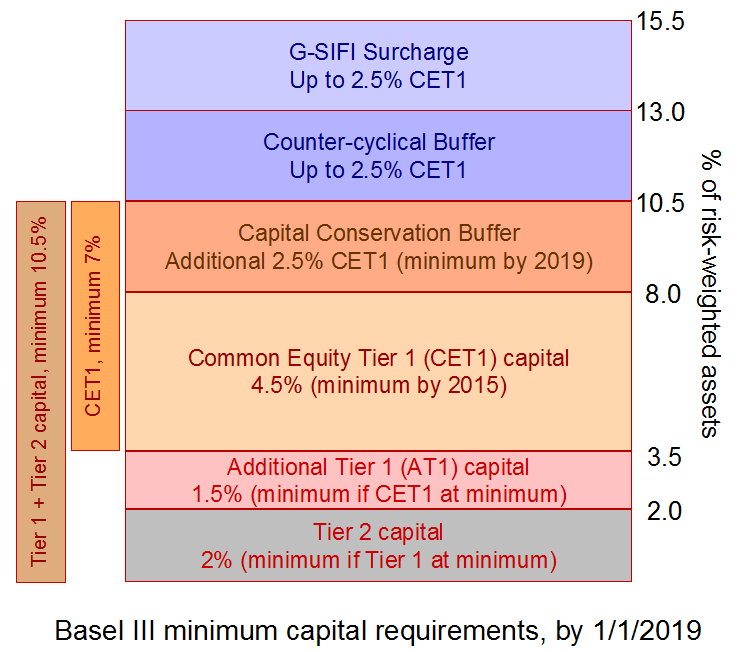 And the end of this year is not the end of the process. After that, further increases in capital will be required, so that by 2019 banks are fully compliant with Basel III. All this will make it difficult for certain banks to raise enough capital from investors. As far as RBS and the Lloyds Banking Group are concerned, this will make the prospect of privatising them more difficult. But that is what the government eventually wants. It does not want the taxpayer to have to find the extra capital. Re-capitalising the banks, or at least some of them, may prove difficult.
And the end of this year is not the end of the process. After that, further increases in capital will be required, so that by 2019 banks are fully compliant with Basel III. All this will make it difficult for certain banks to raise enough capital from investors. As far as RBS and the Lloyds Banking Group are concerned, this will make the prospect of privatising them more difficult. But that is what the government eventually wants. It does not want the taxpayer to have to find the extra capital. Re-capitalising the banks, or at least some of them, may prove difficult.
The following articles look at the implications of the FPC judgement and whether strengthening the banks will strengthen or weaken the rest of the economy.
Articles
Financial policy committee identifies £25bn capital shortfall in UK banks The Guardian, Jill Treanor (27/3/13)
Banks Told To Raise Capital By Financial Policy Committee To Cushion Against A Crisis Huffington Post (27/3/13)
UK banks’ £25bn shortfall: positive for banks, negative for BoE credibility, Sid Verma (27/3/13)
Doubts over Bank of England’s £25bn confidence game The Telegraph, Harry Wilson (27/3/13)
Bank of England tells banks to raise £25bn BBC News (27/3/13)
Q&A: Basel rules on bank capital – who cares? Laurence Knight (13/9/10)
U.K. Banks Seen Avoiding Share Sales After BOE Capital Review Bloomberg Businessweek, Gavin Finch and Howard Mustoe (27/3/13)
Banks Cut Basel III Shortfall by $215 Billion in Mid-2012 Bloomberg (19/3/13)
Will strengthening banks weaken the economy? BBC News, Robert Peston (27/3/13)
Bank of England News Release
Financial Policy Committee statement from its policy meeting, 19 March 2013 Bank of England (27/3/13)
Questions
- Explain the individual parts of the chart.
- What do you understand by risk-weighted assets?
- Distinguish between capital adequacy ratios and liquidity ratios.
- What could the banks do to increase their capital adequacy ratios? Compare the desirability of each method.
- If all banks around the world were Basel III compliant, would this make another global banking crisis impossible?
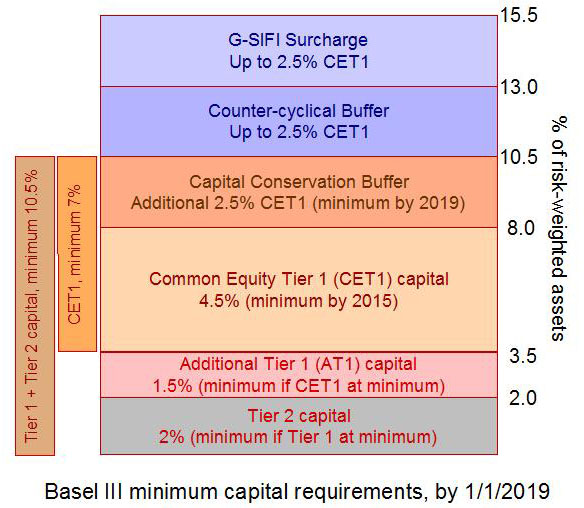 Big challenges face the global community in making its financial institutions more resilient to withstand the difficulties that arise from the macroeconomic environment and, at the same time, better aligning their private interests with those of wider society.
Big challenges face the global community in making its financial institutions more resilient to withstand the difficulties that arise from the macroeconomic environment and, at the same time, better aligning their private interests with those of wider society.
This is no easy task. It is not easy either to keep tabs on the international responses to try and deliver these aims.
This is no better illustrated by some of the recent changes to the capital requirements of financial institutions outlined by the Basel Committee on Banking Supervisions. (Click here for a PowerPoint of the above chart.) The so-called Basel III framework will, in effect, increase the capital that banks are required to hold and, in particular, specific types of capital. In the process this will reduce gearing, i.e. the amount of assets relative to capital. Recent announcements have detailed how large global banks will have to hold even more capital. This blog tries to make sense some of the changes afoot. Further reading is identified below.
The details of the Basel III framework are complex, there are an enormous amounts of financial acronyms to sift through and the definitions of capital change from time. But, at the heart of the proposals is the aim of increasing the resilience of our financial institutions. To do this the proposals focus predominantly on the liability side of a bank’s balance sheet. More specifically, they focus on long-term liabilities which help banks to resource their assets, i.e. to fund their provision of credit (their assets). This capital is ranked by its quality or by tiers; this terminology has recently changed.
Tier 1 capital is now split into two groups: Common Equity Capital (CET1) and Additional Tier 1 (AT1). The former – the ‘best’ capital – is made up of common equity (ordinary share capital) and retained profits. Holders of common equity can expect to receive dividend payments, but these are discretionary, largely dependent on the financial well-being of the firm. The remainder of CET1 are the retained profits of the firms and, hence, that parts of profits which are not distributed to its shareholders (owners). Additional Tier 1 capital – ‘second best’ capital – comprises preference shares and perpetual subordinated debt. Preference shares are more akin to bonds and provide regular coupons. However, their payment continue to place a burden on firms during more difficult financial times. Subordinated debt is debt where the creditors would not have any financial redress before depositors and other creditors have been attended to. Perpetual subordinated debt (bonds) is debt with no maturity date. Finally, Tier 2 capital is subordinated debt where the time to maturity is greater than five years.
The Basel III framework outlines a series of ratios known as Capital Adequacy Ratios (CARs) that financial institutions should meet. The ratios define a type of capital (numerator) relative to risk-weighted assets (denominator). The denominator involves weighting a bank’s category of assets by internationally agreed risk factors. These range from zero for government debt instruments to 1.5 for certain types of loans to companies. In other words, the more risky a given level of assets are the greater is the denominator and the lower is the financial institution’s capital adequacy.
From January 2013, the so-called ‘hard core minimum’ of Basel III, which is a combined level of Tier 1 and Tier 2 capital, will need to be the equivalent to 8 per cent of the bank’s risk-weighted assets. This is actually unchanged from Basel II. But, it is not quite as simple as this. First, the composition of capital matters. The overall 8 per cent ratio must be meet by a Common Equity Capital (CET1) ratio, including retained reserves, of no less than 4.5 per cent (previously 2 per cent). Second, there is the phasing-in between 2016 and 2019 of additional Common Equity Capital (CET1) equivalent to 2.5 per cent of risk-weighted assets. This is known as the Capital Conservation Buffer. Third, depending on the assessment of national regulators/supervisors, like the Bank of England here in the UK, financial institutions generally could be required to hold further Common Equity Capital of between 0 per cent and 2.5 per cent of risk weighted assets. This is known as a Counter-Cyclical Buffer. So, for instance, if the regulators/supervisors become unduly worried by rates of credit growth, they can impose additional capital requirements. This is an example of macroeconomic prudential regulation because it focuses on the financial system rather any one single financial institution.
In September 2011, Basel III added a fourth qualification to the ‘hard core’. This too will be phased-in from 2016. It is to be applied to those financial institutions, which through a series of indicators, such as size, are to be identified as global systemically important financial institutions (G-SIFIs). Depending on their global systemic importance the amount of CET1 relative to risk weighted assets could increase by between a further 1 to 2.5 per cent (and even by as much as 3.5 per cent, if necessary). These four qualifications could take the overall capital adequacy ratio from 8 per cent to as much as 15.5 per cent: 8 per cent plus 2.5 per cent capital conservation buffer plus 2.5 per cent for G-SIB surcharge plus 2.5 per cent for counter-cyclical buffer.
However, capital requirements may be even more stringent in the UK for retail banks. The UK’s Independent Commission on Banking has proposed that retail banks in the UK become legally, economically and operationally independent of the investment part of banks. In other words, that part of the bank which focuses on deposit-taking from households and firms be separated from the investment bank which largely provides services involving other financial institutions. The ICB proposed in its report last Autumn that the separate retail subsidiary faces an overall CAR of between 17 to 20 per cent with a CET1 ratio of at least 10 per cent. We will have to wait to see whether this comes to pass as the government’s legislation passes through Parliament, but it is not expected that the ICB’s proposals come into force before 2019.
Recommended Materials
Final Report: Recommendations Independent Commission on Banking , September 2011. (See Chapter 4 for a readable overview of Basel III and the general principles involved. See Chapter 3 for a discussion of the functional separation of retail and investment banking).
Basel Committee on Banking Supervision reforms – Basel III Bank for International Settlements
Articles
Basel III – the case for the defence Financial Times (23/1/12)
Finance: Banks face a perfect storm that is getting worse Financial Times, Patrick Jenkins (24/1/12)
Banks in EU, US and Japan to face capital reviews BBC News (9/1/12)
Questions
- What is meant by capital and by capital adequacy?
- Explain the construction of a Capital Adequacy Ratio. Distinguish between the CET1 ratio and the overall CAR ratio.
- What do you understand by macro-prudential regulation?
- How do liquidity and capital adequacy differ?
- If financial institutions provide deposits to individuals who can draw out their money readily but extend credit over long periods of time, why don’t financial institutions regularly face financial problems?
 The Brexit vote has caused shockwaves throughout European economies. But there is a potentially larger economic and political problem facing the EU and the eurozone more specifically. And that is the state of the Italian banking system and the Italian economy.
The Brexit vote has caused shockwaves throughout European economies. But there is a potentially larger economic and political problem facing the EU and the eurozone more specifically. And that is the state of the Italian banking system and the Italian economy. If bondholders were large institutional investors, this might not be such a problem, but a significant proportion of bank bonds in Italy are held by small investors, encouraged to do so by tax relief. Bailing in the banks by requiring bondholders to bear significant losses in the value of their bonds could undermine the savings of many Italians and cause them severe hardship, especially those who had saved for their retirement.
If bondholders were large institutional investors, this might not be such a problem, but a significant proportion of bank bonds in Italy are held by small investors, encouraged to do so by tax relief. Bailing in the banks by requiring bondholders to bear significant losses in the value of their bonds could undermine the savings of many Italians and cause them severe hardship, especially those who had saved for their retirement.








